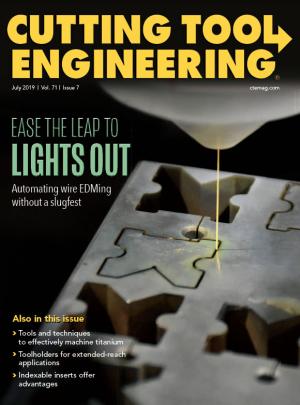The following tips and unusual methods of machining have worked for me and may assist you.
- When I saw some flimsy Delrin parts being run, I hoped I wouldn’t have to get involved. The programmer chose to apply large endmills to machine the parts. Initially, the job was not going well. Parts were being pulled from the vise jaws, and chunks of Delrin were flying. So I asked to get involved. I reprogrammed the parts to be made with smaller-diameter endmills, which cut with less pressure. I also chose to use single-flute cutters with a 0° rake angle when necessary to avoid the lifting forces inherent with positive rake endmills.
- When verifying a program, set center drills to spot only. Let’s face it: We’re only human, and sometimes we screw up. When drilling a part, especially one that already has a lot of time invested in it, care must be taken that holes and other part features end up in their correct locations. One way to verify the setup when drilling is to set the center drill to just lightly spot the surface. If the locations happen to be off for some reason, you’ll have a chance to correct the error.
- Manually set countersink depths at the machine. Countersinking tools run the gamut in terms of how they are made. They vary in numerous ways, such as angle, tool tip size and number of flutes. These variations make it difficult for a programmer sitting at a computer to set a precise depth. Because machinists generally set a precise depth for a countersink tool, a programmer likely won’t know which countersink tool will be used. Instead, I program the tool tip to stay a little above the part and let the machinist manually find the correct Z negative value, which then can be entered into the canned cycle that runs the tool.
The easiest way I’ve found to do this is to run the program until the countersink tool is called up. Then, stop the program by hitting the reset button. After that, start the spindle with the clockwise, or CW, button, and slowly handle-jog the tool to the proper depth in the part. Take note of the depth using the operator’s digital readout. Enter that value in the canned cycle that runs the tool. The only catch is that the operator’s screen must be zeroed in to Z beforehand to the tip of the countersink tool, or the value shown on the screen won’t make sense. Dimensions for countersunk holes are generally not too critical. These dimensions are used mostly for flat-head screws and lead-ins for tapped holes.
- Be especially careful when running large parts with the machine’s doors or windows open. Occasionally, you’ll run into capacity issues with machines. These issues often can be overcome with thoughtful planning. Sometimes, you must leave a machine’s doors or windows open to accommodate a part or feature of a part. Make a mental note to be extra-cautious when doing this. It’s a recipe for crashing because your travel may be limited to the openings of the doors or windows, not the total travel of the machine table. I once saw a nasty crash when a machinist clamped a long plate to a machine table with one end of the plate hanging outside the doors. For whatever reason, the machinist homed the machine. In rapid mode, the table went home but not before leaving a big gash in a door as a result of the edge of the plate slamming into it.
Related Glossary Terms
- canned cycle ( fixed cycle)
canned cycle ( fixed cycle)
Subroutine or full set of programmed NC or CNC steps initiated by a single command. Operations are done in a set order; the beginning condition is returned to when the cycle is completed. See CNC, computer numerical control; NC, numerical control.
- center drill
center drill
Drill used to make mounting holes for workpiece to be held between centers. Also used to predrill holes for subsequent drilling operations. See centers.
- countersink
countersink
Tool that cuts a sloped depression at the top of a hole to permit a screw head or other object to rest flush with the surface of the workpiece.
- countersinking
countersinking
Cutting a beveled edge at the entrance of a hole so a screw head sits flush with the workpiece surface.
- flutes
flutes
Grooves and spaces in the body of a tool that permit chip removal from, and cutting-fluid application to, the point of cut.
- rake
rake
Angle of inclination between the face of the cutting tool and the workpiece. If the face of the tool lies in a plane through the axis of the workpiece, the tool is said to have a neutral, or zero, rake. If the inclination of the tool face makes the cutting edge more acute than when the rake angle is zero, the rake is positive. If the inclination of the tool face makes the cutting edge less acute or more blunt than when the rake angle is zero, the rake is negative.
- sawing machine ( saw)
sawing machine ( saw)
Machine designed to use a serrated-tooth blade to cut metal or other material. Comes in a wide variety of styles but takes one of four basic forms: hacksaw (a simple, rugged machine that uses a reciprocating motion to part metal or other material); cold or circular saw (powers a circular blade that cuts structural materials); bandsaw (runs an endless band; the two basic types are cutoff and contour band machines, which cut intricate contours and shapes); and abrasive cutoff saw (similar in appearance to the cold saw, but uses an abrasive disc that rotates at high speeds rather than a blade with serrated teeth).


